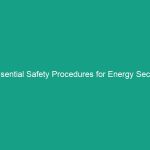Introduction
Good morning team,
Today, we are going to discuss an important topic that directly influences our Safety and health in the workplace: Essential Sequencing Strategies for Enhanced HSE Compliance. Understanding and implementing effective sequencing strategies can significantly improve our compliance with health, safety, and environmental Regulations, ultimately ensuring a safer working Environment for everyone.
Why does this matter? Because when we prioritize Safety, we not only protect ourselves but also our coworkers and the reputation of our organization. So, let’s dive into this crucial topic together.
Understanding Essential Sequencing Strategies
Essential sequencing strategies refer to the systematic approach we take in planning and executing tasks to enhance compliance with Health, Safety, and Environment (HSE) standards. These strategies help us identify, manage, and mitigate risks associated with our operations.
By applying these strategies, we can streamline our processes, reduce accidents, and ensure that safety protocols are followed consistently. Many employees think that HSE compliance is solely the responsibility of management; however, it’s a collective effort that involves everyone in the workplace.
Key Hazards, Risks, and Safety Considerations
Incorporating essential sequencing strategies into our daily operations allows us to identify specific Hazards and risks that may arise from disorganized or poorly sequenced tasks. Here are some common hazards:
- Slip and Trip Hazards: Poorly sequenced tasks can lead to cluttered workspaces, increasing the likelihood of slips and falls.
- Equipment Malfunction: Neglecting the proper order of operations may cause equipment to fail, leading to accidents.
- Inadequate Training: If tasks are not sequenced correctly, employees may not receive the necessary training and supervision, increasing risk exposure.
Ignoring these safety protocols can have real-world consequences, such as injuries, downtime, and even legal actions. It’s essential to recognize these risks to foster a proactive safety culture.
Best Practices, Procedures, & Actionable Advice
Implementing essential sequencing strategies involves a series of Best Practices that promote HSE compliance. Here are some actionable steps to follow:
1. Conduct Regular Risk Assessments
Regularly assess the risks associated with your tasks. Identify potential hazards and implement Control Measures before starting any job.
2. Develop Clear Procedures
Create clear, step-by-step procedures for each task. This helps ensure everyone knows their responsibilities and how to perform their jobs safely.
3. Prioritize Tasks
Prioritize tasks based on their potential risks. High-risk activities should be sequenced to minimize exposure and prevent accidents.
4. Use Checklists
Utilize checklists to ensure all Safety Measures are followed before commencing work. This can significantly reduce the risk of oversight.
5. Continuous Training
Provide ongoing training to employees about the importance of sequencing in HSE compliance. Share real-life case studies where improper sequencing led to accidents.
For example, a construction site that failed to sequence its safety checks experienced a significant accident due to equipment failure. This incident highlighted the importance of following established protocols.
Regulations, Standards, and Compliance
Compliance with safety regulations is critical to maintaining a safe work environment. Familiarize yourself with relevant OSHA, ISO, and company-specific safety Standards. These regulations are in place to protect us and ensure that we conduct our jobs safely.
Understanding these standards helps us appreciate the significance of compliance, which ultimately leads to fewer workplace incidents and a more productive work environment.
Employee Engagement & Discussion
Now that we’ve covered essential sequencing strategies for enhanced HSE compliance, I want to hear from you. What safety challenges have you encountered related to task sequencing? Are there specific procedures you think could be improved? Your feedback is crucial for refining our safety practices and making our workplace safer for everyone.
Conclusion & Key Takeaways
In conclusion, essential sequencing strategies are vital for enhancing HSE compliance in our workplace. By conducting regular risk assessments, developing clear procedures, prioritizing tasks, using checklists, and providing continuous training, we can significantly reduce hazards and improve our overall safety culture.
Remember, safety is everyone’s responsibility. Let’s commit to applying these practices and ensure we prioritize safety in all our operations.
Thank you for your attention and your ongoing commitment to creating a safer workplace. Together, we can make a difference!


